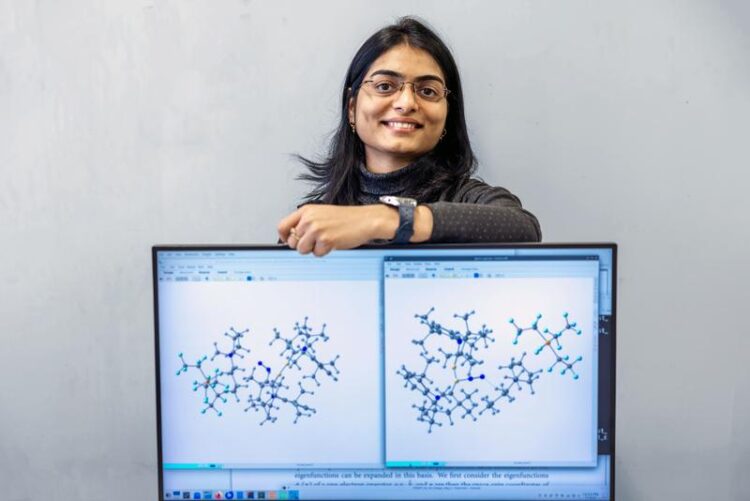Studying small-molecule activation

Expert in computational chemistry: Shailja Jain develops a new generation of catalysts
Credit: Uli Regenscheit / University Stuttgart
Humboldt fellow Shailja Jain is investigating catalysts for green chemistry.
She uses quantum technologies for observing molecules: Computational chemist Shailja Jain is visiting the Institute for Theoretical Chemistry at the University of Stuttgart for two years as a Humboldt postdoctoral fellow. In the team of Professor Johannes Kästner, she wants to advance the development of a new generation of catalysts for sustainable chemical processes.
“I want to shed light on the structures, bonding, and reaction dynamics of metal-free small molecule activation,” says Shailja Jain. How do molecules bond? How do these bonds break? What influences chemical reactions? How long do they take and how much energy is consumed in the process? To be able to answer questions like these, Jain simulates chemical reactions on the computer, follows the reaction pathway step by step and computes the predicted behavior of molecules using quantum mechanics.
Welcome to the interdisciplinary team
With her expertise, she is most welcome in the interdisciplinary team of Johannes Kästner, who is heading the computational chemistry research group at the Institute for Theoretical Chemistry. “Shailja Jain is extremely knowledgeable not only about the mechanisms behind chemical reactions, but also about the catalysts that accelerate and control these reactions,” says Kästner. “She is able to analyze these systems in detail.” Using computer-aided calculations and predictions, he and his team are complementing the work of experimental scientists – joint basic research that is intended to support very different scientific fields, ranging from battery and materials research to drug development to the optimization of industrial production processes.
Sustainable catalysts for efficient processes
During her research stay in Stuttgart, Jain is examining nitrogen, in particular, and its behavior in interaction with different catalysts. This molecule is abundant in the air and an ideal starting product for the synthesis of fertilizers from ammonia, which has been produced on an industrial scale for decades. However, this can be problematic because the process requires temperatures of up to 500 degrees Celsius and pressures of up to 350 bar and is thus energy-intensive, expensive, and environmentally harmful. “For efficient and sustainable production processes, we will need alternative ideas to activate the molecules,” Jain explains. The new generation of catalysts that she is investigating need to be produced in a resource-friendly manner, work at low pressure and room temperature, and they must be non-toxic.
Advancing the green chemistry of the future
“I want to use my knowledge, my creativity, and my enthusiasm for computational chemistry for advancing not only my field of research, but also the green chemistry of the future,” Jain points out. She has been passionate about mathematics and science since she was a high-school student. Encouraged by her parents, she enrolled at the university in Sagar, central India, where she completed her Bachelor’s and Master’s degrees. After that, she took the next major step and moved to Pune, which was 24 hours away by train. There, she obtained her doctoral degree at the National Chemical Laboratory (NCL) with a computational study on solvation effects. In 2021, she ventured the step of going abroad and started as a postdoc at the Hebrew University in Jerusalem in the research group of the renowned computational chemist Sason Shaik.
Encouraging young researchers
Since September 2023, Jain has been living and doing research in Stuttgart. She is one of the selected talented scientists from all over the world who were honored by the Humboldt Foundation for their outstanding achievements and decided to join the University of Stuttgart. She explores the city from her new home on the university campus in Vaihingen. When she is not investigating molecules and working on the catalysts of the future, she is riding a bicycle and she is cooking – Indian food. It was not easy for her to leave her home country, she says today. But she took the chance to gain experience in renowned research teams, and also to gain insight into different cultures. “I hope that my research expedition will encourage other young scientists to broaden their horizons and fulfill their own career aspirations.”
Wissenschaftliche Ansprechpartner:
Prof. Dr. Johannes Kästner, University of Stuttgart, Institute for Theoretical Chemistry, phone: +49 711 685-64473, email: kaestner@theochem.uni-stuttgart.de
Dr. Shailja Jain, University of Stuttgart, Institute for Theoretical Chemistry, phone: +49 711 685-64413, email: jain@theochem.uni-stuttgart.de
Media Contact
All latest news from the category: Interdisciplinary Research
News and developments from the field of interdisciplinary research.
Among other topics, you can find stimulating reports and articles related to microsystems, emotions research, futures research and stratospheric research.
Newest articles

Optimising the processing of plastic waste
Just one look in the yellow bin reveals a colourful jumble of different types of plastic. However, the purer and more uniform plastic waste is, the easier it is to…

Anomalous magnetic moment of the muon
– new calculation confirms standard model of particle physics. Contribution of hadronic vacuum polarization determined with unprecedented accuracy. The magnetic moment of the muon is an important precision parameter for…

Antibodies can improve the rehabilitation of people with acute spinal cord injury
Antibody that Neutralizes Inhibitory Factors Involved in Nerve Regeneration Leads to Enhanced Motor Function after Acute Spinal Cord Injury. Researchers at 13 clinics in Germany, Switzerland, the Czech Republic and…



